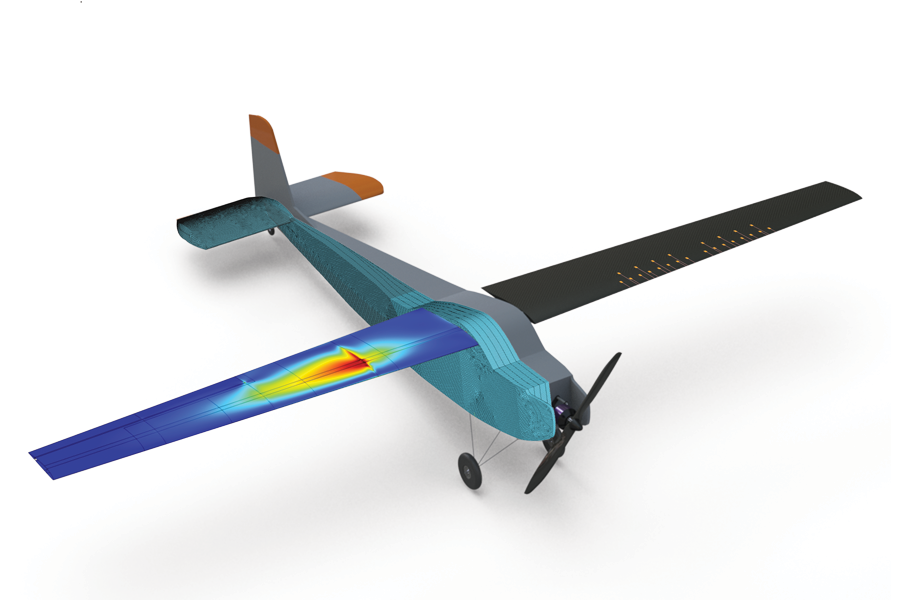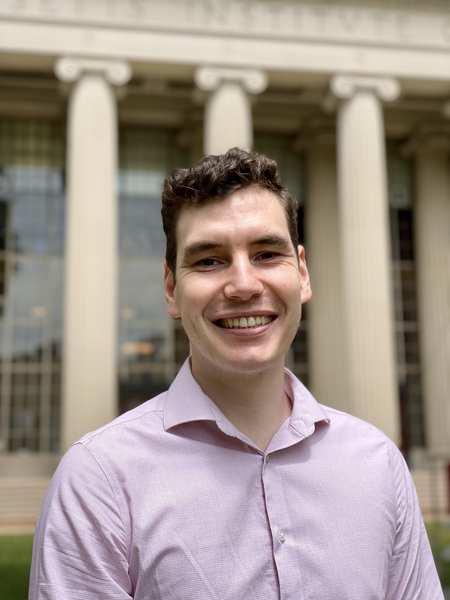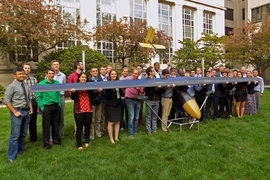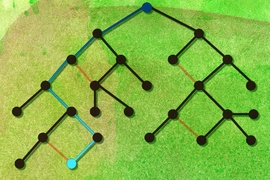Picture this: A delivery drone suffers some minor wing damage on its flight. Should it land immediately, carry on as usual, or reroute to a new destination? A digital twin, a computer model of the drone that has been flying the same route and now experiences the same damage in its virtual world, can help make the call.
Digital twins are an important part of engineering, medicine, and urban planning, but in most of these cases each twin is a bespoke, custom implementation that only works with a specific application. Michael Kapteyn SM ’18, PhD ’21 has now developed a model that can enable the deployment of digital twins at scale — creating twins for a whole fleet of drones, for instance.
A mathematical representation called a probabilistic graphical model can be the foundation for predictive digital twins, according to a new study by Kapteyn and his colleagues in the journal Nature Computational Science. The researchers tested out the idea on an unpiloted aerial vehicle (UAV) in a scenario like the one described above.
“The custom implementations that have been demonstrated so far typically require a significant amount of resources, which is a barrier to real-world deployment,” explains Kapteyn, who recently received his doctorate in computational science and engineering from the MIT Department of Aeronautics and Astronautics.
“This is exacerbated by the fact that digital twins are most useful in situations where you are managing many similar assets,” he adds. “When developing our model, we always kept in mind the goal of creating digital twins for an entire fleet of aircraft, or an entire farm of wind turbines, or a population of human cardiac patients.”
“Their work pushes the boundaries of digital twins’ custom implementations that require considerable deployment resources and a high level of expertise,” says Omer San, an assistant professor of mechanical and aerospace engineering at Oklahoma State University who was not involved in the research.
Kapteyn’s co-authors on the paper include his PhD advisor Karen Willcox SM ’96, PhD ’00, MIT visiting professor and director of the Oden Institute for Computational Engineering and Sciences at the University of Texas at Austin, and former MIT engineering and management master’s student Jacob Pretorius ’03, now chief technology officer of The Jessara Group.
Evolving twins
Digital twins have a long history in aerospace engineering, from one of its earliest uses by NASA in devising strategies to bring the crippled Apollo 13 moon mission home safely in 1970. Researchers in the medical field have been using digital twins for applications like cardiology, to consider treatments such as valve replacement before a surgery.
However, expanding the use of digital twins to guide the flight of hundreds of satellites, or recommend precision therapies for thousands of heart patients, requires a different approach than the one-off, highly specific digital twins that are created usually, the researchers write.
To resolve this, Kapteyn and colleagues sought out a unifying mathematical representation of the relationship between a digital twin and its associated physical asset that was not specific to a particular application or use. The researchers’ model mathematically defines a pair of physical and digital dynamic systems, coupled together via two-way data streams as they evolve over time. In the case of the UAV, for example, the parameters of the digital twin are first calibrated with data collected from the physical UAV so that its twin is an accurate reflection from the start.
As the overall state of the UAV changes over time (through processes such as mechanical wear and tear and flight time logged, among others), these changes are observed by the digital twin and used to update its own state so that it matches the physical UAV. This updated digital twin can then predict how the UAV will change in the future, using this information to optimally direct the physical asset going forward.
The graphical model allows each digital twin “to be based on the same underlying computational model, but each physical asset must maintain a unique ‘digital state’ that defines a unique configuration of this model,” Kapteyn explains. This makes it easier to create digital twins for a large collection of similar physical assets.
UAV test case
To test their model, the team used a 12-foot wingspan UAV designed and built together with Aurora Flight Sciences and outfitted with sensor “stickers” from The Jessara Group that were used to collect strain, acceleration, and other relevant data from the UAV.
The UAV was the test bed for everything from calibration experiments to a simulated “light damage” event. Its digital twin was able to analyze sensor data to extract damage information, predict how the structural health of the UAV would change in the future, and recommend changes in its maneuvering to accommodate those changes.
The UAV case shows how similar digital-twin modeling could be useful in other situations where environmental wear and tear plays a significant role in operation, such as a wind turbine, a bridge, or a nuclear reactor, the researchers note in their paper.
“I think this idea of maintaining a persistent set of computational models that are constantly being updated and evolved alongside a physical asset over its entire life cycle is really the essence of digital twins,” says Kapteyn, “and is what we have tried to capture in our model.”
The probabilistic graphical model approach helps to “seamlessly span different phases of the asset life cycle,” he notes. “In our particular case, this manifests as the graphical model seamlessly extending from the calibration phase into our operational, in-flight phase, where we actually start to use the digital twin for decision-making.”
The research could help make the use of digital twins more widespread, since “even with existing limitations, digital twins are providing valuable decision support in many different application areas,” Willcox said in a recent interview.
“Ultimately, we would like to see the technology used in every engineering system,” she added. “At that point, we can start thinking not just about how a digital twin might change the way we operate the system, but also how we design it in the first place.”
This work was partially supported by the Air Force Office of Scientific Research, the SUTD-MIT International Design Center, and the U.S. Department of Energy.









